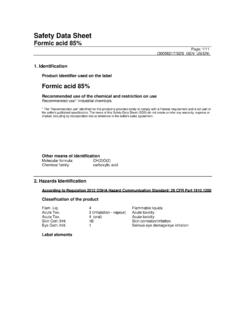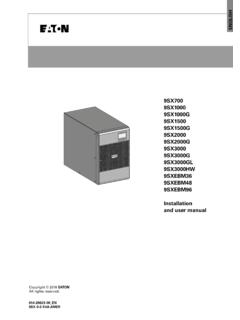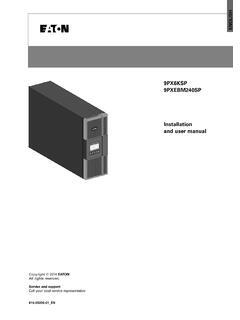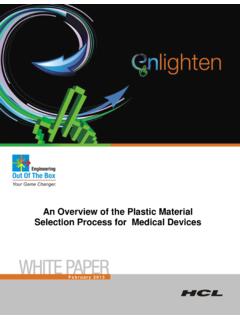Transcription of GENERAL PFAS - Michigan
1 800-662-9278 10/2018 GENERAL PFAS SAMPLING GUIDANCE This document contains an introduction to PFAS, biosecurity recommendations, and GENERAL recommendations to decrease the possibility of cross-contamination. Michigan Department of Environmental Quality Revised 10/16/2018 Michigan Department of Environmental Quality 800-662-9278 10/2018 GENERAL PFAS SAMPLING Guidance CONTENTS Acronyms .. i Disclaimer .. 2 Introduction .. 2 Purpose and Objectives .. 3 Farm Biosecurity .. 3 Scheduling .. 3 Before Sampling .. 3 While Sampling .. 3 After Sampling .. 3 GENERAL PFAS Sampling .. 4 Sampling Objectives.
2 4 PFAS Cross-Contamination Potential Sources .. 4 PFAS-Free Water .. 5 Materials Screening .. 5 Sampling Equipment .. 6 Field Clothing and Personal Protective Equipment (PPE) .. 7 Sun and Biological Protection .. 9 Personnel Hygiene and Personal Care Products (PCPs) .. 11 Food Packaging .. 11 PFAS Sampling Procedures .. 12 Sample Containers, Handling, and Collection .. 12 Sample Shipment .. 12 Preferential Sampling Sequence .. 13 Decontamination Procedures .. 13 Laboratory Considerations .. 14 Quality Control Samples .. 16 Laboratory Quality Control Samples .. 16 Field Quality Control Samples.
3 16 References .. 17 Trademarks .. 19 GENERAL PFAS Sampling Guidance 800-662-9278 10/2018 Acronyms Acronyms used throughout the GENERAL PFAS Sampling Guidance document and/or each sampling guidance are as follows: AFFF Aqueous film forming foam CAS Number Chemical abstracts service number COC Chain of Custody DEPA Danish Environmental Protection Agency (Denmark) EINECS European List of Notified Chemical Substances (European Union) ENCS Existing and New Chemical Substances Inventory (Japan) ETFE Ethylene-tetrafluoroethylene FCMP Fish Contaminant monitoring program FCSV Fish consumption screening values FDA Food and Drug Administration (United States of America)
4 FEP Fluorinated ethylene propylene HASP Health and safety Plan HDPE High- density polyethylene IECSC Inventory of Existing Chemical Substances Produced or Imported in China ITRC Interstate Technology & Regulatory Council KECI Korea Existing Chemicals Inventory (South Korea) KEMI Swedish Chemical Agency (Sweden) ldpe Low- density polyethylene LHA Lifetime Health Advisory (United States Environmental Protection Agency) MDEQ Michigan Department of Environmental Quality MDHHS Michigan Department of Health and Human Services MPART Michigan PFAS Action Response Team MSDS Material safety data Sheet (former reference) ng/L Nanograms per liter NZIoC New Zealand Inventory of Chemicals (New Zealand)
5 PCPs Personal care products PID Photoionization detector PFAA Perfluoroalkyl acids PFAS Per- and Polyfluoroalkyl Substances PFC Polyfluorocarbons PFCA Perfluoroalkyl carboxylic acids PFOA Perfluorooctanoic acid PFOS Perfluorooctanesulfonic acid PFPE Perfluoropolyethers PFSA Perfluoroalkyl sulfonic acids PICCS Philippine Inventory of Chemicals and Chemical Substances (Philippines) ppb Parts per billion PPE Personal protection equipment ppt Parts per trillion PTFE Polytetrafluoroethylene PVC Polyvinyl chloride PVDF Polyvinylidene fluoride PVF Polyvinyl fluoride QA/QC Quality assurance/quality control QAPP Quality Assurance Project Plan OECD Organization for Economic Cooperation and Development SDS safety data Sheet SWAS Surface Water Assessment Section (MDEQ) TSCA Toxic Substances Control Act (United States of America)
6 USEPA United States Environmental Protection Agency UV Ultraviolet VOC Volatile organic compounds WRD Water resources division (MDEQ) i GENERAL PFAS Sampling Guidance - Prohibited - Allowable - Needs Screening 2 Disclaimer The Michigan Department of Environmental Quality (MDEQ) intends to update the information contained within this PFAS Sampling Guidance document as new information becomes available. The user of this PFAS Sampling Guidance is encouraged to visit the Michigan PFAS Action Response Team webpage ( ) to access the current version of this document.
7 Introduction Per- and polyfluoroalkyl Substances (PFAS) are a class of emerging contaminants composed of more than 3,000 human-made, fluorinated, organic chemicals (Buck et al., 2011, Wang et al., 2017). The actual number of compounds is continuously changing, as some PFAS are no longer produced due to regulatory and voluntary actions, while new ones are created as alternatives. The carbon-fluorine bond that exists in PFAS is one of the strongest bonds in nature, they are tough to break and are resistant to thermal, chemical, and biological degradation. Due to their unique chemical properties, various PFAS can lower surface tension (act as surfactants), are oil-repelling (oleophobic), and are water-repelling (hydrophobic), yet are also relatively water soluble.
8 They have been used extensively in many industries worldwide for a wide variety of applications. PFAS were first invented in the late 1930 s and commercially used from the 1940 s as non-stick coatings. PFAS continued to be used in many industries and various products as more PFAS were developed with unique chemical properties. Some of the documented PFAS uses are in hydraulic fluids, biocides, construction products, fire-fighting foams, household products, wetting and mist suppressing agents, surfactants for oil and natural gas recovery enhancement, polymerization agents, low-friction bearings and seals, insulators, cables, wires, protective coatings for a wide variety of materials, nonstick coatings, surgical patches, cardiovascular grafts, implants, oil and water repellent coatings for a wide range of materials such as paper and cardboard packaging products, carpets, leather products, and textiles (OECD, 2013)
9 The presence of PFAS in these materials is a potential source of environmental concern and cross-contamination. The probability of false positives is relatively high during PFAS sample collection due to the potential for many sources of cross-contamination, combined with low laboratory detection limits (nanograms per liter (ng/L) or parts per trillion (ppt)). There are many products that could be found in the sampling environment, that have not been documented to either contain or not contain PFAS, and may come into contact with the samples, introducing causing cross-contamination. The United States Environmental Protection Agency (USEPA) has established a Lifetime Health Advisory (LHA) for Perfluorooctanoic acid (PFOA) and Perfluorooctanesulfonic acid (PFOS), separately or combined, of 70 ppt.
10 The MDEQ cleanup criteria protective of groundwater used for drinking water purposes is also 70 ppt for PFOS and PFOA, individually or combined. The MDEQ has also promulgated a standard under Rule 57 for PFOS of 11 ppt for surface water that is used as a drinking water source and 12 ppt for surface water that is not used as a drinking water source. NOTE: Emerging Contaminants are chemicals and materials in the environment and present real or potential human health or environmental risks, and Do not have peer-reviewed human health standards or: Standards/regulations are evolving due to new science, new laboratory analytical capabilities, and new knowledge about the chemicals.
















